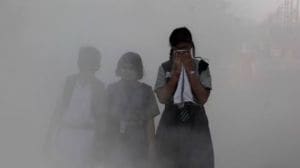Canada Calling: Of illegal migrants from US, Indian students in fake colleges and Jagmeet’s Tik Tok loss
Canada has left no stone unturned to make these illegal immigrants feel at home. In a sharp contrast with America and its treatment of asylum seekers on the Mexican border, the Canadian government has put them up in hotels.
 Jagmeet Singh from NDP
Jagmeet Singh from NDP
Sharing your only land border* with the world’s richest country – the proverbial land of plenty – has its own advantages. You don’t have to worry a whole lot about illegal border crossings into your territory. This has been true for Canada for nearly two centuries. The nearly 9000-km land border that it shares with the United States is not only the world’s longest but also the most peaceful (or uneventful, whichever you prefer). Unlike the heavily guarded and politically charged US-Mexico border, the US-Canada border is an afterthought, almost an imaginary line on a truly vast, indistinguishable landscape. But the times are changing, and suddenly Canada is looking southwards alarmed.
Illegal border crossings into Canada from the US have seen a sharp spike since 2022. According to official numbers – nearly 40,000 people claimed asylum in Canada last year, and all but 369 went to Quebec. Most were from Haiti. The French-speaking province of Quebec has always been a favored destination for francophone Hatians: Montreal, QC, is home to a large Haitian diaspora. But owing to a spate of overlapping crises since last year – political as well as natural – the Caribbean country is on the verge of collapse, and more Hatians than before are fleeing the country.
So far, Canada has left no stone unturned to make these illegal immigrants feel at home. In a sharp contrast with America and its treatment of asylum seekers on the Mexican border, the Canadian government has put them up in hotels. In the renowned tourist destination of Niagara Falls, thousands of rooms have been booked for the asylum seekers. But this latest surge is straining the resources thin, leading the premier of Quebec to ask Prime Minister Justin Trudeau to speak with US President Joe Biden and put a stop to this influx.
Americans have a complaint of their own
But before Justin Trudeau could broach the subject of illegal border crossings, the Americans hit back. Canada, in America’s imagination, is their bucolic backyard. Which is not far from the truth either. Canada is basically America with the metric system, restrictive gun laws, less ugly politics, and a better view of Niagara Falls.
But this week Republican lawmakers looked northward rather agitated. On Tuesday, they asked Biden to stem the flow of illegal immigrants – those that are coming in from Canada. The thing is, while there have been illegal crossings into Canada from the States, an even larger number of illegal migrants have been going in the opposite direction. Since the pandemic restrictions were lifted, these numbers have exploded. According to the U.S. Customs and Border Protection, in the 12 months between October 2021 and September 2022, almost 110,000 people crossed over illegally from Canada to the US. And the biggest chunk – nearly 41,000 – were from India. Their modus operandi is to fly into Canada on tourist visas, even on student visas, and then make the southward journey. After walking across the border, they are picked up by traffickers – whom they have paid – and transported to their final destinations.
In four months between October 2022 and January 2023, the floodgates have really opened. Nearly 57,000 migrants from Canada have already walked over to the other side: 13,000 of those were Indians. Late autumn and winter are the most unforgiving seasons in Canada and northern United States, but that’s also when crossings increase sharply as wintry conditions make patrolling difficult for border agents. Sometimes, the American dream dies a premature death, and the issue comes into the spotlight. Last year, in January a Gujarati family froze to death in the border town of Emerson, Manitoba, while trying to trek into the US during a blizzard. They had flown into Canada only days earlier. Last month, a Mexican man froze to death while trying to cross into Vermont from Quebec. These tragedies might force some to pause and reflect, but as the numbers suggest, they don’t deter most from taking risks.
Fake college admission scam comes to light
Indian students are heading to Canada in record numbers. Last year, out of 550,000 international students arrived in the Great White North, half(226,000) were from India. This year, the number of Indian students is poised to cross 300,000. If you have got your acceptance letter from a Canadian college, congratulations, but you would do well to take a better look at it again. It might be fake. This is what happened to Karamjeet Kaur. According to a report in the CBC, Kaur, 25, arrived in Canada from Punjab in 2018 after her Indian agent obtained an admission letter from Seneca College, Toronto. When she landed in the city, the agent told her that the deal with the college fell through, and that he could instead get her a spot in a private college. Kaur took the matters in her hand, and secured admission in NorQuest College in Edmonton. She completed her studies, got a job, and applied for permanent residency in 2020. A year later, however, she was told by the Canadian Border Services Agency that her admission letter from Seneca College was fake. Then, in January last year, Kaur was told by the Immigration and Refugee Board of Canada that she would need to leave Canada as she was given a study permit on the basis of a fraudulent letter. Kaur went for a judicial review – but in a decision last month, a federal court quashed her appeal.
Kaur’s case is by no means an exception. After the verdict, the issue dominated Indo-Canadian radio talk shows – and a number of callers shared that they too were duped by their agent, and were facing expulsion.
TikTok ban impacts Jagmeet Singh most
Amid reports of Chinese interference in Canadian politics, the government here cracked down on TikTok blocking it on all government devices, citing data privacy risks. It might not have been the Liberal Party government’s stated aim, but, right off the bat, the ban appears to have impacted Justin Trudeau’s rivals the most. Allow me to explain.
According to a study, 26 percent of Canadian adults use TikTok. Among youngsters it is by far the most popular app: 76 percent of those between 18-24 use the micro-video platform. It’s this demographic that both the Conservative Party of Canada and the New Democratic Party have aggressively been trying to woo through the app. And no one has leveraged it better than NDP leader Jagmeet Singh. Singh is, by some distance, the most popular Canadian politician on the TikTok – with just shy of a million followers (which might not sound a lot to Indians, but then Canada’s population is only 38 million). In fact, it’s often said in jest that if Canadian elections were to take place on TikTok, Singh would be the prime minister. The government ban, however, left him with no other option but to deactivate his account. Intended or not, in one move, Trudeau has sought to give the impression that he is tough on China, while also undercutting his political adversaries. What’s the word for it in the Indian political lexicon? Yes, a masterstroke!
* Till June 2022, Canada shared a land border with only the United States. That changed when an obscure hunk of exposed rock in the high Arctic, Hans Island, was divided between Canada and Greenland, which is part of the Kingdom of Denmark. With a 1.2 kilometre line bisecting the island, Canada got a new neighbor.)
(Daksh Panwar is an Ontario-based journalist and broadcaster. Twitter: @Daksh280)







